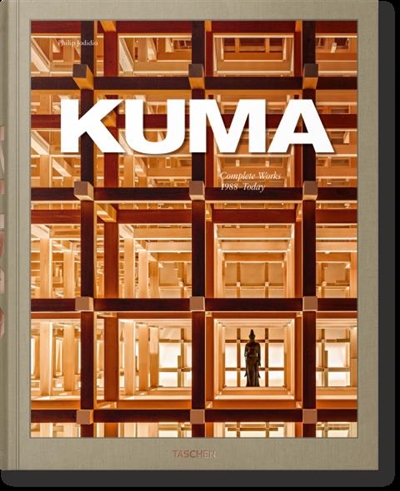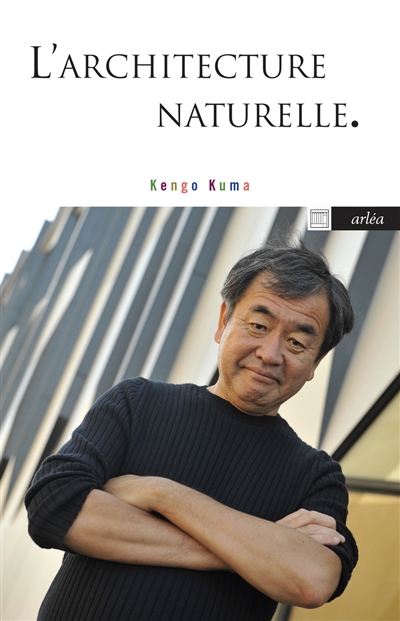Recherche simple :
- Sujet : Kuma, Kengo (1954-....)
Documents en rayon : 7
par Kuma, Kengo (1954-....)
A.D.A. Edita
2020
-
Disponible - 70"19" KUMA 2
Niveau 3 - Arts
par Frampton, Kenneth (1930-....)
Thames & Hudson
2013 -
-
Disponible - 70"19" KUMA 2
Niveau 3 - Arts
Résumé : The quintessential Japanese architect of today, Kengo Kuma has forged a modern design language that artfully combines the countries traditional building crafts with sophisticated technologies and materials. Associating a deep understanding and respect for native construction techniques with a more globalized outlook than many of his compatriots, Kengo Kumas work represents a significant generational shift in a country rich with contemporary architecture. From his iconic Glass House (1995) to the Nezu Museum in Tokyo, this is the Complete record of Kengo Kumas built work, comprising twentyfour projects to date. Architecture historian Kenneth Frampton frames Kumas work in the context of post-war Japans flourishing architecture scene and influential figures and offers a perspective on the international acclaim of Kumas ideas and buildings. Projects are organized by the material themes that have come to define the architects output: Water and Foliage; Wood; Bamboo and Grass; and Stone and Ceramics. Kuma develops a personal and architectural reflection on each. Each building is presented through descriptive text, newly commissioned photographs and detailed drawings, this last revealing a privileged view of the refined architectonic vocabulary that characterizes Kumas buildings. With the close collaboration of Kuma, this major monograph fully documents a leading light of the global architecture scene, offering a rich insight into contemporary interpretations of Japans ancient building traditions. This beautifully produced book will be an inspiration to any designer who aims to create spaces for history and the future. (source : Dawson)
par Jodidio, Philip (1954-....)
Taschen
2021 -
-
Disponible - AR US KUM
Niveau 3 - Arts
Résumé : Présentation de l'ensemble des créations de l'architecte japonais. ©Electre 2021
par Houdart, Sophie (1971-....) ; Minato, Chihiro (1960-....) ; Kuma, Kengo (1954-....)
Éd. Donner lieu
2009 -
-
Disponible - 70"19" KUMA 2
Niveau 3 - Arts
Résumé : Interprétation de l'oeuvre architecturale du Japonais Kuma Kengo. Anthropologues, les auteurs proposent une approche ethnographique des espaces, des volumes et des formes conçues par ce bâtisseur aimant les matières simples et les textures sophistiquées.
par Kuma, Kengo (1954-....) ; Cadou, Catherine ; Kawarada, Chizuko
Arléa
2020 -
-
Disponible - 70"19" KUMA 1
Niveau 3 - Arts
Résumé : En huit chapitres et autant de matériaux et de réalisations emblématiques, le concepteur du stade olympique de Tokyo et du FRAC de Marseille expose le principe fondamental de l'architecture japonaise, le lien de l'homme à la nature. L'ouvrage est à la fois une histoire subjective de la discipline et un manuel d'application pratique. ©Electre 2020
par Kuma, Kengo (1954-....)
Parenthèses
2021 -
-
Disponible - 70"19" KUMA 1
Niveau 3 - Arts
Résumé : Marqué par la visite d'un bâtiment de Kenzo Tange à Tokyo, l'architecte découvre sa vocation à l'âge de 10 ans. Ayant acquis en trente ans une importante notoriété, au fil d'une oeuvre caractérisée par une économie de moyens, une sensibilité poétique et une inventivité audacieuse, il présente nombre de ses projets à travers 25 histoires axées sur les quartiers de la capitale japonaise. ©Electre 2021

 Les bibliothèques de la ville de Paris
Les bibliothèques de la ville de Paris
 Les bibliothèques universitaires
Les bibliothèques universitaires
 La BnF
La BnF
 L'encyclopédie Wikipédia
L'encyclopédie Wikipédia
 L'Encyclopædia Universalis
L'Encyclopædia Universalis
 La bibliothèque du film
La bibliothèque du film
 La médiathèque de la Philharmonie de Paris
La médiathèque de la Philharmonie de Paris












